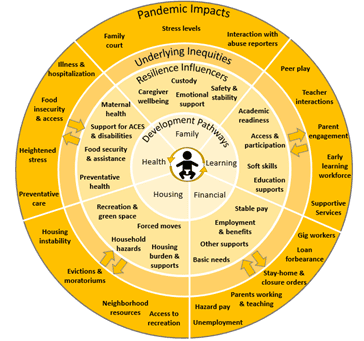How can we measure the developmental impacts of the COVID-19 pandemic on young children?

Across the United States and around the world, children and families are starting a new school year. Typically a time of excitement and new beginnings, the first day of school has again been overshadowed by the COVID-19 pandemic.
We’ve learned a lot about the virus over the past 18 months. However, the ways in which COVID-19 impacts the youngest children (from birth to age 5), especially in the long term, remains a large and underexplored question. What does COVID-19 mean for the healthy development and resilience of these children?
From the womb to age 5 is a critical period for the development of brain architecture. Young children are fully dependent on their parents and caregivers to support their health and wellbeing, and the pandemic has put unprecedented stresses on caregivers. COVID-related illness, hospitalizations, workforce disconnection or disruption and mental health needs have directly affected those adults, possibly resulting in decreased capacities to meet children’s basic needs. Deeply rooted systemic inequities in health, housing, education, wealth, and others have caused Black, Indigenous, and People of Color to more heavily be impacted by the harmful and disruptive effects of COVID-19.
“COVID isn’t just about health, it impacts every dimension of a child’s life. Integrated data are essential if we really want to break down systemic silos and find solutions capable of addressing the future needs of a generation of young children living through this pandemic.”
Alyssa Ward, Behavioral Health Clinical Director of the Virginia Medicaid Program, and mother of 2, age 3 and 8
Understanding the pandemic’s impacts on the youngest will be crucial to charting the path forward — and because of how multifaceted childhood development is, it’s a difficult question. Everything from health to income, race to access to early education, from maternal well-being while in utero to other, even more subtle factors, can play a role. How should we know what to measure? We set out to explore what data sources, methods and expertise can help us understand the pandemic’s impact on babies and young children. The findings are presented in a new article in the International Journal on Population Data Science, which provides a guide to studying young children in the context of COVID-19.
[Read the full article here]
At the heart of that guide is the use of integrated data systems (IDS) to answer complex questions about how COVID-19 has altered the intersecting pathways that impact children’s developmental resiliency: learning, family, health, housing and financial stability.
 Integrated data systems streamline data sharing from a diverse set of sectors, such as education, health, and social services, and link those data at the individual level, allowing researchers, policy makers, and others to better understand needs and outcomes across complex systems (for more on IDS, see this introductory article).
Integrated data systems streamline data sharing from a diverse set of sectors, such as education, health, and social services, and link those data at the individual level, allowing researchers, policy makers, and others to better understand needs and outcomes across complex systems (for more on IDS, see this introductory article).
IDS also allows for the potential to link child-level data with the data of their immediate caregivers, creating a unique opportunity to study children in the context of their households and other environments with high levels of influence (e.g. schools and neighborhoods).
This paper is a call to action for collaborative research and action on what COVID-19 means for young children in the short, intermediate, and long term.
To learn more about the Urban Institute’s integrated data system, visit the Institute for Social Capital page.